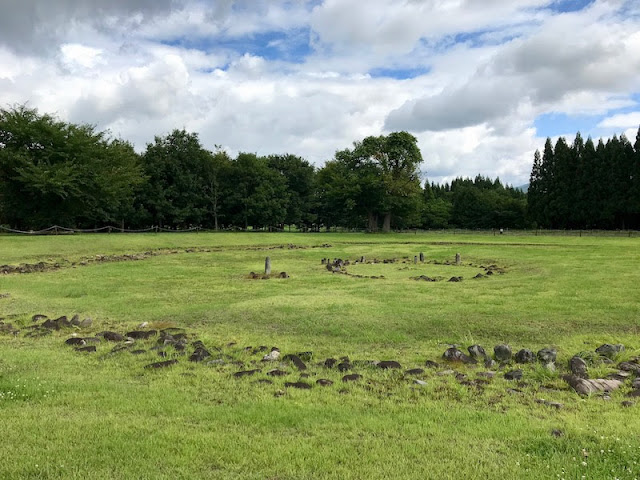北秋田の伝説とミステリー Legend and Mystery in North Akita
秋田県鹿角市大湯の環状列石(ストーンサークル)。二重の円になっている。
One of the Oyu stone circles, Kazuno city, Akita prefecture, consists of inner and outer circles.
再び北鹿の旅のつづき。いまに伝わる伝説の地をいくつかめぐった。
I travelled around the northern part of Akita to see legends and mysteries.
環状列石 Stone Circle
これはいまから3000〜4000年前、縄文時代後期の遺跡で、直径 30 m くらいの円(実際には二重、三重の同心円)をえがくように石を並べてある。おもに東北北部から北海道南部にかけて、似たような遺跡が普遍的にみられるので、だれかの突発的なアイディアでつくられたのではなく、縄文人の文化、風習に根ざした、なんらかの意味をもつことは確実である。石といってもけっこうな大きさなので、相当の理由がなければこんな重いものを川原から段丘の上まで運ばないだろう。縄文人の墓地、あるいはなんらかの儀式、まつりをおこなう施設とされているが、くわしいことは謎である。
The stone circles were built in the late Jomon period (about 3000 to 4000 years ago), widely distributed in the north Tohoku and the south Hokkaido areas. They are considered to be a cemetery or a place where some religious ceremony took place, though the correct purpose is unknown.
冒頭の写真は国の特別史跡に指定されている鹿角市大湯のストーンサークル。内側のサークルのそばに、小さな石組みがあって、これは日時計の役目を果たしたといわれている。この写真のとなりにもうひとつサークルがあるが、それらが夏至の日没の方向に並んでいるらしく、太陽信仰や北欧の夏至まつりのようなものを想像させる。資料館が併設されていて、発見の経緯、土器や土偶などの発掘品が展示されていた。
The photo in the above is the stone circle in Oyu, Kazuno city. A smaller stone structure near the inner circle is perhaps a sundial. Two stone circles have been found in Oyu and they are aligned along the direction of the sundown at the summer solstice, suggesting that the stone circles have a meaning relating to the Sun or a kind of midsummer feast. Claywares and dogu (clay dolls) found there are displayed in a museum.
大館能代空港のすぐそばの伊勢堂岱遺跡にもストーンサークルが複数ある。道路建設の際に発見され、遺跡保存のため計画変更して道路を迂回させたそうだ。多くの土偶がみつかっているが、ほとんどは破損している。意図的に壊されて埋められたのではないかとも言われている。キノコ形の土器や種々の土製品、石器も発掘されていて、なんらかの儀式につかわれたとされる(参考: MIHO MUSEUM 編、土偶・コスモス、羽鳥書店、2012)。
There are also several stone circles at Isedotai, Kita-Akita city, near Odate Noshiro Airport. They were found during a road construction and the construction plan was changed to preserve them. Many dogu have been found but almost all of them are incomplete, suggesting that they were intentionally broken before buried. Various claywares and stonewares such as Mushroom-like small articles have also been found, which were probably used in some ceremony by Jomon people.
Stone circles at Isedotai.
Dogu displayed at a museum in Isedotai.
老犬神社 Old Dog Shrine
The shrine was so gorgeous that I can't believe this is just for a dog.
ご神体が「犬」という一風変わった神社。JR花輪線沢尻駅から米代川をわたった対岸の山の中腹にある。杉木立の参道はけっこうな山登りで、一汗かく。
This is a unique shrine that was built for a dog. It is located on a cedar forest hill across Yoneshiro river from Sawajiri station of JR Hanawa Line.
神社の由来は大要以下のとおり。むかしむかし、定六という猟師がいまの鹿角市の草木という集落に妻と住んでいた。猟に出るときはいつも猟犬のシロといっしょだった。ある日、獲物を深追いして山奥に分け入り、隣国(青森県の三戸領とされる)に出たところ、他国で無断で猟をしたかどで役人に捕まって投獄されてしまった。定六は、先祖の勲功により、代々どの領地でも自由に狩猟できる免状をもっていたが、その日に限って家に忘れてしまい、申し開きできなかった。牢に幽閉されていたところ、シロがどこからともなく入ってきた。そこでシロに免状をもってくるように言いつけると、シロは走って定六の妻の待つ家にもどり、いつも免状を置いている棚の前でワンワン吠えた。妻は定六の受難をさとり、シロの首に免状を結わえつけて定六のもとへ走らせた。しかしシロが到着する前に、定六は処刑されてしまった。シロはその後も主人の最期の地に何度も通って、吠え続けた。シロの遠吠えが聞こえた秋田・青森の県境の森をいまでも犬吠森と呼んでいる。定六亡き後、妻とシロはこの地に移り住んだ。シロの死後、何度も災いが起こり、シロの怨念ではないかと不安がった村人は、シロを手厚くまつり、ほこらを建てた。それが老犬神社である。おしまい(参考: 神社前の案内板、小野忠太郎「秋田の風物」東洋館出版社 1952)。
An old tale says: Long time ago, Sadaroku, a hunter, lived with his wife and Shiro, a white dog, in Kusaki village, Kazuno. One day, Sadaroku went hunting with Shiro as usual but accidentally reached out of the Kazuno territory. He was arrested for hunting in an unpermitted area, but he thought it's ok. Sadaroku had a special license to hunt anywhere. However, he left it at home that day, and he couldn't make an excuse. Sadaroku talked to Shiro to take the license from home. Shiro understood the words and ran back home to bark around the license box. Sadaroku's wife soon understood and put the license on the dog's neck to help Sadaroku. When Shiro arrived, Sadaroku had already been executed. People heard Shiro's howls from a mountain, which is now called "Inuboe-Mori" (Dog's howl forest). Sadaroku's wife and Shiro moved to this place. After Shiro died, many disasters occurred. People thought they were caused by Shiro's deep‐seated grudge, so people built the Roken (old dog) shrine to respect the dog's spirit.
シロは秋田犬ということになっていて、あの渋谷のハチ公もおどろく忠犬ぶりをいかんなく発揮したのである。さいきん秋田犬が人気らしい。大館市内に秋田犬会館という建物があって、飼育されている秋田犬を実際に見られるみたいだったので、行ってみた。建物の外、玄関、それと秋田犬保存会の事務所内の一角にもいた。秋田犬の博物室も併設されていて、品評会の歴代の表彰犬の写真がかざってあった。みんな誇らしげだ。顔だけ見ると柴犬とみまちがうかもしれないが、見分け方は、秋田犬は顔のパーツがセンター寄りで、顔のまわりの肉づきがよくてぽてっとしているところ。見慣れてくると、なんともかわいらしい。
Shiro was Akitainu (an inherent dog species in Akita), which is known to be the most faithful dog species in Japan (e.g., Hachi-ko that waited his master at Shibuya station even after the master's death). I went to the Akitainu museum in Odate, where we can see displays about the history of Akitainu and also some living Akitainu. Akitainu competitive shows are held every spring and fall, and photos of award winners were displayed. Every dog shows a proudful face. The face of Akitainu looks similar to Shibainu. The difference is that the parts of Akita's face are more ceterized than Shiba, and Akita's face is fatter.
Akitainu who won at contests.
錦木塚 Nishikigi-Zuka
JR花輪線十和田南駅からすぐ近くの公園の一角に鎮座している。錦木伝説の大要を述べれば以下のとおり:
今から千数百年前、代々この地を治める家に政子姫という機織りの上手な娘がいた。村の子どもが大鷲にさらわれる事件があったときには、旅僧のおしえに従って鳥の羽を混ぜ込んだ布を三年三ヶ月の月日を費やして織りあげ、それを村人に与えたところ、たしかにそれ以来大鷲が寄りつかなくなったいう、それほどに人望のあつい娘だった。あるとき錦木を売る青年がこの政子姫を知り、求婚した。錦木とは五色に染めた三尺あまりの木の束で、別名仲人木ともいい、婚礼の際、男が女に贈る習わしがあった。青年はこの錦木を姫の家の前に置いたが、姫の父は身分の差を理由に結婚を許さず、錦木の受領を拒んだ。錦木の束が千束になる雪の日、青年は病に倒れ亡くなった。政子姫はそれを知り、嘆き悲しんで、あとを追うように亡くなった。姫の父は二人の亡きがらを一緒に葬り、錦木とともに埋めた。これが錦木塚である。塚のそばに大銀杏があり、旧暦7月7日には青年の霊がこの木に宿って五色に輝くという。
この伝説はその後広く知られ、「錦木」「狭布(けふ)の細布」は平安後期には歌枕として詠まれ、室町時代には世阿弥によって謡曲「錦木」がつくられた。岩手県出身の力士、錦木の四股名もここに由来する(公園の案内板、小野忠太郎「秋田の風物」東洋館出版社 1952 など)。
Nishikigi-Zuka.





